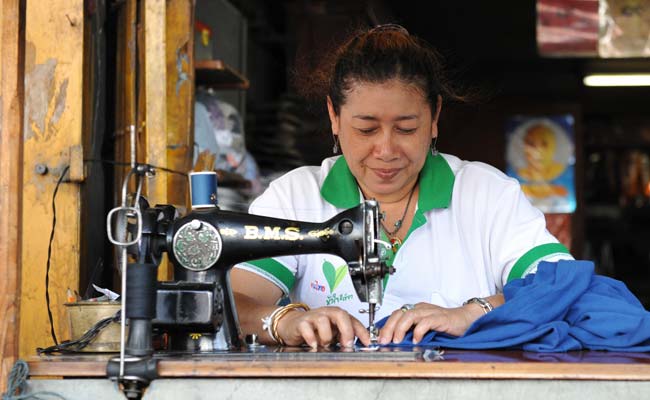
NBFC-Micro Finance firms to play a key role in financial inclusion
The Dollar Business Bureau  By increasing the income cap for the eligibility of a micro-loan borrower as well as the permissible total borrower indebtedness, the Reserve Bank of India (RBI) has indicated its strong support to non-banking financial companies – microfinance institutions ‘(NBFC-MFIs)’ role in financial inclusion. The new move is likely to significantly increase the potential market size without affecting borrowers’ servicing ability and improve operating efficiency of NBFC-MFIs, said a report by the rating agency, India Ratings & Research (Ind-Ra). This move could also be a precursor to expanding NBFC-MFIs’ role in financial inclusion if they maintain and strengthen their underwriting standards. Also, existing MFIs may be tempted to slow down their branch expansion in non-south states, providing opportunities for new players. RBI proposes to widen the consumer base of MFIs by nearly doubling the income limits of an eligible borrower to Rs 100,000 from Rs 60,000 in rural areas and Rs 1,60,000 from Rs 1,20,000 in urban areas. It also proposes to increase the total borrower indebtedness to Rs 1,00,000 from Rs 50,000. These changes could nearly double the long - term potential of the sector and bring a wider section of poor within the ambit of microfinance. At the same time, MFIs would also have the incentive to increase penetration for existing borrowers as they would qualify for loans with higher amounts in - line with the growth in rural incomes. NBFC - MFIs’ current underwriting standards seem adequate. This is because in spite of RBI allowing them to lend up to Rs 50,000, only few districts especially in south India and some other states have been saturated in terms of borrower indebtedness or having micro-loans from two or more MFIs, the report said. They have now been provided sufficient headroom to grow for the next five years. If MFIs ensure a correlation between income, needs and loans, they will not be under pressure to dilute underwriting standards to showcase portfolio growth. Recently, the Prime Minister, Narendra Modi has asked the bankers to study the successful micro finance models being followed in other parts of the world and try to adapt them according to the local requirements. Speaking after the launch of the Pradhan Mantri Mudra Yojana aimed at funding the small entrepreneurs of India, Modi said that while there are a number of facilities provided for the large industries in India, there is a need to focus on 5 crore 75 lakh self-employed people who use funds of Rs 11 lakh crore, with an average per unit debt of merely Rs 17,000 to employ 12 crore Indians, reported a PIB release. The Prime Minister said that MUDRA scheme is aimed at “funding the unfunded”. MUDRA will build on experiences of some of the existing players, who have demonstrated ability to cater to the Non Corporate Small Business segment to build a financing architecture and right eco-system for both the entrepreneurs as well as the last mile financiers to the segment. Access to finance in conjunction with rational price is going to be the unique customer value proposition of MUDRA. The establishment of MUDRA would not only help in increasing access of finance to the unbanked but also bring down the cost of finance from the Last Mile Financiers to the informal micro/small enterprises sector. The approach goes beyond credit only approach and offers a credit – plus solution for these myriad micro enterprises, creating a complete ecosystem spread across the country, said the Prime Minister.
By increasing the income cap for the eligibility of a micro-loan borrower as well as the permissible total borrower indebtedness, the Reserve Bank of India (RBI) has indicated its strong support to non-banking financial companies – microfinance institutions ‘(NBFC-MFIs)’ role in financial inclusion. The new move is likely to significantly increase the potential market size without affecting borrowers’ servicing ability and improve operating efficiency of NBFC-MFIs, said a report by the rating agency, India Ratings & Research (Ind-Ra). This move could also be a precursor to expanding NBFC-MFIs’ role in financial inclusion if they maintain and strengthen their underwriting standards. Also, existing MFIs may be tempted to slow down their branch expansion in non-south states, providing opportunities for new players. RBI proposes to widen the consumer base of MFIs by nearly doubling the income limits of an eligible borrower to Rs 100,000 from Rs 60,000 in rural areas and Rs 1,60,000 from Rs 1,20,000 in urban areas. It also proposes to increase the total borrower indebtedness to Rs 1,00,000 from Rs 50,000. These changes could nearly double the long - term potential of the sector and bring a wider section of poor within the ambit of microfinance. At the same time, MFIs would also have the incentive to increase penetration for existing borrowers as they would qualify for loans with higher amounts in - line with the growth in rural incomes. NBFC - MFIs’ current underwriting standards seem adequate. This is because in spite of RBI allowing them to lend up to Rs 50,000, only few districts especially in south India and some other states have been saturated in terms of borrower indebtedness or having micro-loans from two or more MFIs, the report said. They have now been provided sufficient headroom to grow for the next five years. If MFIs ensure a correlation between income, needs and loans, they will not be under pressure to dilute underwriting standards to showcase portfolio growth. Recently, the Prime Minister, Narendra Modi has asked the bankers to study the successful micro finance models being followed in other parts of the world and try to adapt them according to the local requirements. Speaking after the launch of the Pradhan Mantri Mudra Yojana aimed at funding the small entrepreneurs of India, Modi said that while there are a number of facilities provided for the large industries in India, there is a need to focus on 5 crore 75 lakh self-employed people who use funds of Rs 11 lakh crore, with an average per unit debt of merely Rs 17,000 to employ 12 crore Indians, reported a PIB release. The Prime Minister said that MUDRA scheme is aimed at “funding the unfunded”. MUDRA will build on experiences of some of the existing players, who have demonstrated ability to cater to the Non Corporate Small Business segment to build a financing architecture and right eco-system for both the entrepreneurs as well as the last mile financiers to the segment. Access to finance in conjunction with rational price is going to be the unique customer value proposition of MUDRA. The establishment of MUDRA would not only help in increasing access of finance to the unbanked but also bring down the cost of finance from the Last Mile Financiers to the informal micro/small enterprises sector. The approach goes beyond credit only approach and offers a credit – plus solution for these myriad micro enterprises, creating a complete ecosystem spread across the country, said the Prime Minister.
This article was published on April 17, 2015 – 12.42 pm IST.





 to success.
to success.